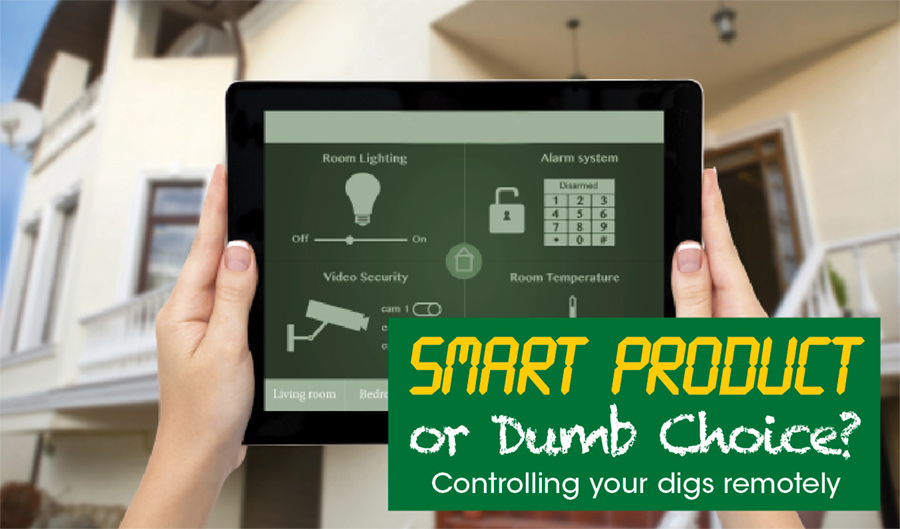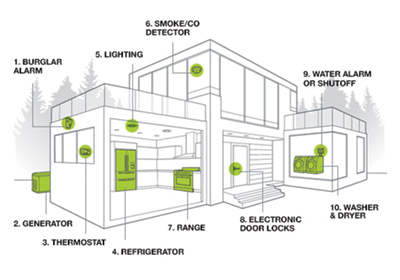
By Brack Johnson
You're on your way to work in Garner, to play in Durham or to take off from RDU, and you can't remember whether you turned off the lights and switched on the security system or locked the door.
 Do you go back home? Continue on your way and hope for the best? Or, asks Consumer Reports, do you simply pull out your smart phone, open an app or two, and make sure everything is OK?
Do you go back home? Continue on your way and hope for the best? Or, asks Consumer Reports, do you simply pull out your smart phone, open an app or two, and make sure everything is OK?
The nonprofit magazine says convenience, control and peace of mind is the powerful combination that smart products are selling.
Mainstream corporations, such as Amazon, AT&T, Home Depot, Lowe's, Staples and Verizon, sell smart products and services that let you run your home from your phone (and other devices). Home automation is becoming difficult to ignore, given those companies' huge advertising budgets.
Product selection is growing, with 37 billion smart products expected on the market by the year 2020, says network-hardware maker Cisco.
Already in position:
- Ranges and ovens can be set to preheat during your drive home, so you can get dinner on the table faster.
- A side-by-side refrigerator texts you if a door is ajar, helping you save energy and prevent food from spoiling.
- Dryers can tell you if your exhaust duct is clogged, which prolongs drying time, wastes energy, and is a fire hazard.
- Appliances can self-diagnose problems via your smart phone, potentially saving on repair costs or time waiting for the service technician.
The public is definitely intrigued. Almost 20 percent of Consumer Reports subscribers already use their phone or tablet to remotely control some of their home, and almost 70 percent of those who don't voiced interest in doing so in the future. The items readers most want to manage remotely are thermostats, security systems, blinds, lighting and door locks.
The lab experts and investigative reporters at Consumer Reports researched which products can make your life easier, which fail at their basic function, and which may leave you vulnerable.
Their picks and pans are based on months of testing and analysis of benefits, payback time, up-front and ongoing costs, and other concerns. Here are their findings:
Wi-Fi network is vulnerable
You must be cautious about the security settings of each device. This is true even if the security settings on your home's router limits access to devices you've authorized. It doesn't matter whether it's a whole-house suite of products controlling lighting, security and smoke/CO alarms, or just an Internet-enabled fork.
Otherwise, the device could allow hackers – and whomever they sell your data to – access to other connected products in your abode, such as the computers on your home network.
In one cyberattack, about 100,000 products, such as routers, TVs and at least one connected refrigerator, sent out more than 750,000 phishing e-mails over two weeks, according to security consulting firm Proofpoint. The blame: weaknesses in their basic protections or setup.
Privacy can be a problem
An unconnected "dumb" gadget shares no information that you might prefer to keep to yourself, such as when your crash pad is empty.
But a smart thermostat might be less discreet, alerting hackers when it's in vacation mode. Or the history log of a smart-lock app might let thieves learn when you usually return from work without having to stake out your place.
Bet on the wrong horse?
Connectivity is still young, with no clear winner among competing technologies. So, you can control a product via its app on your phone, but you'll need multiple apps to control your household, which isn't all that convenient.
The alternative, a suite of products from a single brand or that run on the same wireless standard, such as ZigBee or Z-Wave, leaves you vulnerable to potentially buying into the Betamax of smart products.
Based on testing by Consumer Reports, some product designs need refinement, unless you like being an unpaid beta tester.
Certain connected products deliver. But so far, the promise of an easy, centrally controlled smart home has yet to catch up with reality.
 A world of choices
A world of choices
The possibilities seem endless, judging from what's available and the increased bundling by top-name companies of multiple products with one controller – and, of course, monthly fees.
Home size and construction, plus the distance between devices, make a difference. Drywall and plywood should do fine, but nonporous materials such as plaster, brick and stone could slow down or block signals.
1. Burglar alarm – Enables you to monitor multi-device systems from afar.
2. Generator – Tells you whether the generator is working and can e-mail or text you and a service technician if there's a problem.
3. Thermostat – Senses patterns in human presence and controls equipment accordingly.
4. Lighting – Gives you the power to control lights from an app and set vacation schedules.
5. Smoke/CO detector – Notifies you and prompts a same-brand thermostat to shut off fuel-burning appliances.
6. Refrigerator – Alerts you if power is out and if a door is left ajar.
7. Range – Allows you to preheat the oven, set the timer, and check cooking status without being in the room.
8. Electronic door locks – Permits you to remotely lock or unlock and change who's authorized to enter.
9. Water alarm or shutoff – Texts you when water is spilling from a pipe or an appliance. (Shutoffs can cut off your water main to minimize flooding.)
10. Washer and dryer – Lets you start cycles and monitor progress; warns you if your dryer duct is clogged.
Are they worth it?
Internet-enabled products often cost more than their low-tech siblings. It's important to do your research and make a buying decision based on factors such as ease of use, price, convenience and security.